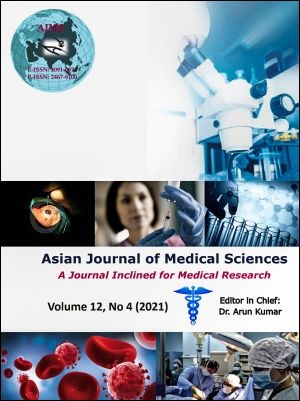Comparative study between WIDAL and DOT ELISA in the diagnosis of Typhoid fever
Keywords:
DOT ELISA, Salmonella typhi, Widal test, Blood cultureAbstract
Background: Typhoid fever, also known as enteric fever, is a communicable disease, found only in man and occurs due to systemic infection mainly by Salmonella typhi organisms. Blood culture is regarded as the gold standard for diagnosis and carry 70-75% diagnostic yield in the first week of illness.
Aims and Objective: To compare the sensitivity and specificity of Widal test and dot ELISA with blood culture in the early diagnosis of Typhoid fever.
Materials and Methods: A Cross-Sectional study was carried out in the Department of Microbiology, Era’s Lucknow Medical College and Hospital for a period of 18 months. Patients presenting with acute febrile illness suspicious of typhoid fever accompanied by clinical signs and symptoms of typhoid fever in the absence of any other known febrile illnesses, were included in the study. Widal and Dot ELISA was performed using serum samples and for blood culture aseptically collected blood was used.
Results: Sensitivity, Specificity, PPV, NPV of DOT ELISA as compared to Blood culture for typhoid positivity was found to be 92.6%, 83.7%, 55.6% and 98.1% respectively. Diagnostic accuracy of DOT ELISA as compared to Blood culture was found to be 85.3%. Conclusion: For both early and late diagnosis of typhoid fever with high sensitivity as well as accuracy for identification of typhoid fever, the rapid diagnostic test (Dot Elisa) is better than the Widal test. However, it may be an increased burden to healthcare owing to a low positive predictive value in a low prevalence scenario.
Downloads
Downloads
Published
How to Cite
Issue
Section
License
Authors who publish with this journal agree to the following terms:
- The journal holds copyright and publishes the work under a Creative Commons CC-BY-NC license that permits use, distribution and reprduction in any medium, provided the original work is properly cited and is not used for commercial purposes. The journal should be recognised as the original publisher of this work.
- Authors are able to enter into separate, additional contractual arrangements for the non-exclusive distribution of the journal's published version of the work (e.g., post it to an institutional repository or publish it in a book), with an acknowledgement of its initial publication in this journal.
- Authors are permitted and encouraged to post their work online (e.g., in institutional repositories or on their website) prior to and during the submission process, as it can lead to productive exchanges, as well as earlier and greater citation of published work (See The Effect of Open Access).




